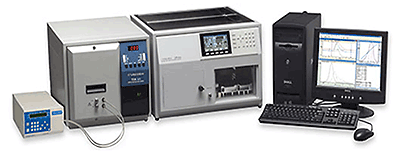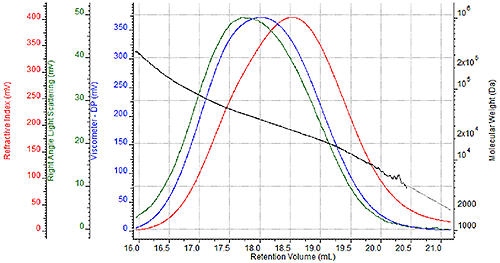Gel permeation chromatography (GPC) or, equivalently, size-exclusion chromatography (SEC) is a widely used technique to characterize a wide variety of macromolecules, including, but not limited to commodity or bulk manufactured polymers. This technique can be used to measure the molecular weight moments, molecular weight distribution, the intrinsic viscosity, and/or hydrodynamic size of these macromolecules. Figure 1 shows a complete setup for a GPC system.

|
While conditions that are both effective and practical have been determined for many of these commodity polymers (i.e. THF for polystyrene, chlorinated benzenes for polyolefins), some need further optimization in one aspect or another. This application note describes one such polymer, nylon, where changes in operating conditions can lead to improvements in both cost and health and safety.
Typical GPC analysis of nylons has involved the use of phenolic based solvents (o-chlorophenol, m-cresol, phenol blends) or hexafluoroisopropanol (HFIP) for the dissolution solvent and/or mobile phase. Of these solvents, HFIP provides significant benefits over the phenolic solvents with lower quantifiable health and safety hazards (i.e. higher LD50 limits) and substantially higher signal-to-noise ratios in both refractive index and light scattering detectors due to a higher dn/dc. The main drawback to HFIP is the potentially prohibitive cost which can range from $2 to $4 (or more) per mL.
Formic acid has historically been used to measure the solution viscosity of nylon. From the standpoint of the metrics mentioned previously, formic acid is equivalent or better than HFIP with respect to health and safety. The LD50 limit is slightly higher with formic acid, and the significantly lower vapor pressure of formic acid inherently leads to a lower potential for inhalation exposure. On the issue of price, formic acid costs significantly less than HFIP, in the range of $0.15 to $0.30 per mL.
Some drawbacks to using formic acid as a mobile phase are it does not dissolve all forms of nylon, specifically nylon-11 and nylon-12. Also, formic acid can be extremely caustic to many of the traditional components of liquid chromatography systems. The Viscotek TDA Triple Detection GPC System, shown in Figure 1 and used for this study, has specific, proprietary design components that allow for the use of formic acid as a mobile phase. Finally, dissolved nylon samples will have a decreased signal-to-noise ratio compared to HFIP due to a lower dn/dc of these samples in formic acid. The following section illustrates whether or not that decreased signal-to-noise ratios would prevent adequate GPC analysis of nylons in formic acid.
A series of four nylon-6 samples were prepared twice for GPC analysis, once for analysis in a mobile phase of HFIP with 0.05M potassium trifluoroacetate and once for analysis in a mobile phase of 88% formic acid. Figure 2 shows a triple detector chromatogram of one of the samples in HFIP, and Figure 3 shows a triple detector chromatogram of the same sample in formic acid. The following chromatograms show the refractive index signal in red, the viscometer signal in blue, and the right angle light scattering (RALS) signal in green. The calculated molecular weight at each retention volume is also shown in black to visualize the sample’s molecular weight distribution.

|

|
While the chromatograms and associated molecular weight distributions appear similar with the two different mobile phases, a more detailed numerical comparison is needed to accurately assess the efficacy of formic acid as a mobile phase.
Table 1 below compares the molecular data obtained for the four nylon-6 samples using HFIP as the mobile phase and using 88% formic acid (FA) as the mobile phase. Presented values include the moments of the molecular weight distribution (Mn, Mw, and Mz) and intrinsic viscosity ([η]). Data presented are the average of three injections.
| Sample ID | Solvent | Mn (Da) | Mw (Da) | Mz (Da) | PDI | [η] (dL/g) | dn/dc (mL/g) |
|---|---|---|---|---|---|---|---|
| Nylon – A | HFIP | 21636 | 32651 | 45728 | 1.51 | 1.025 | 0.27 |
| Nylon – A | FA | 23083 | 32487 | 46085 | 1.41 | 0.970 | 0.12 |
| Nylon – B | HFIP | 21054 | 30882 | 42775 | 1.47 | 0.979 | 0.27 |
| Nylon – B | FA | 21471 | 31523 | 46183 | 1.47 | 0.934 | 0.12 |
| Nylon – C | HFIP | 54449 | 75578 | 103602 | 1.39 | 1.867 | 0.27 |
| Nylon – C | FA | 49276 | 69940 | 100235 | 1.40 | 1.909 | 0.12 |
| Nylon – D | HFIP | 41981 | 59200 | 81740 | 1.41 | 1.590 | 0.27 |
| Nylon – D | FA | 38711 | 54576 | 79453 | 1.41 | 1.559 | 0.12 |
Table 1 shows the calculated data for the different nylon samples in each mobile phase. The molecular weight distribution is nearly identical for all samples (< 10% difference). The [η] are also correlates nicely between the two different mobile phase. In this instance, the correlation is nearly unity, but this is more of a coincidence. Different mobile phases could swell the polymer chains to different degrees which would lead to different [η] for the same sample.
For a cost comparison, running these samples in HFIP cost more than $1600 while running these same samples in 88% formic acid cost less than $125. In fact, the total cost of running all the samples in formic acid (~$125) is less than the cost of running a single injection of one of the samples in HFIP (~$140).
For the GPC analysis of nylon-6, nylon-6,6, or potentially other soluble polyamides, formic acid provides an effective, inexpensive, and safer alternative to mobile phases traditionally used for these polymers. The Viscotek TDA Triple Detection GPC System provides outstanding signal-to-noise ratios for the robust and precise analysis of nylons in formic acid. In addition, the Malvern GPC system has been specifically designed to reliably operate under the potentially corrosive conditions posed by formic acid and other solvents.